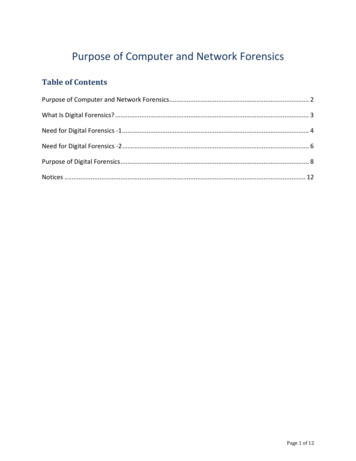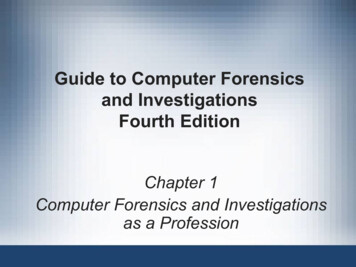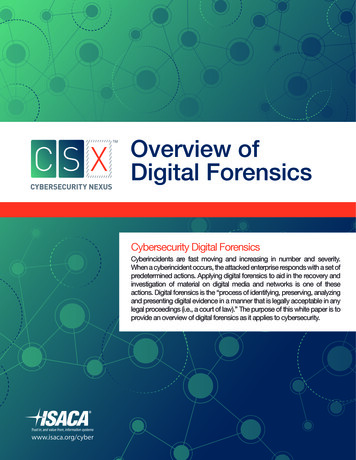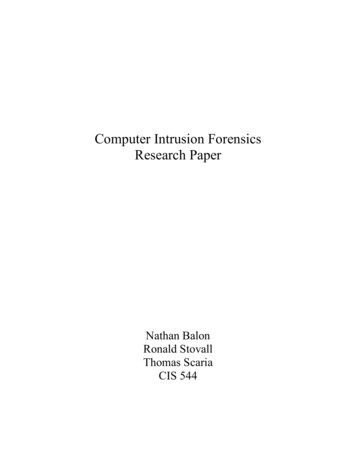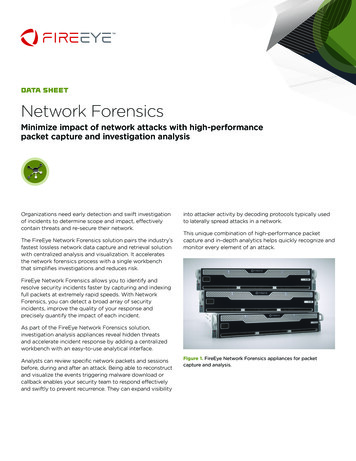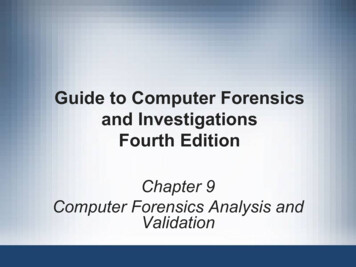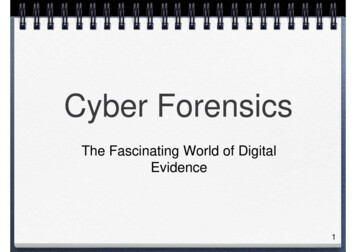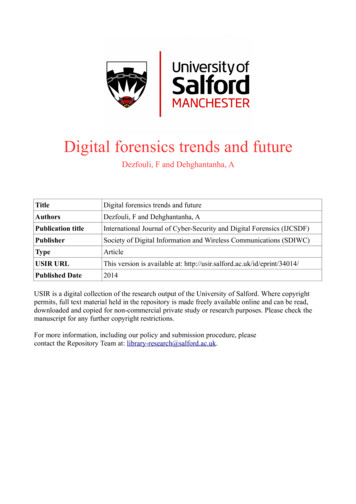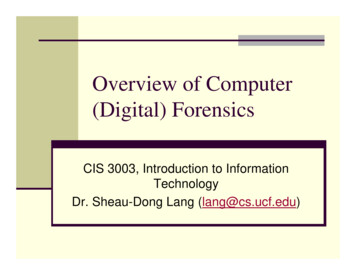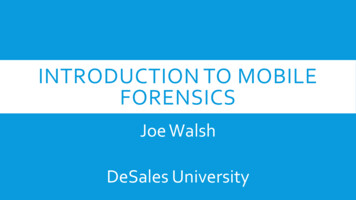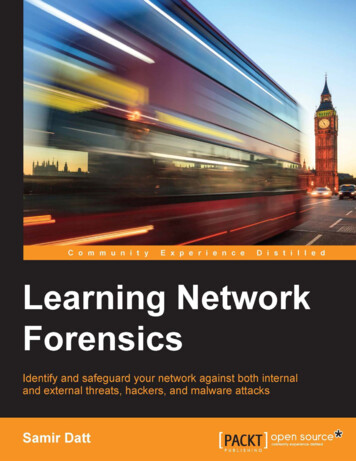
Transcription
[1]
Learning Network ForensicsIdentify and safeguard your network againstboth internal and external threats, hackers,and malware attacksSamir DattBIRMINGHAM - MUMBAI
Learning Network ForensicsCopyright 2016 Packt PublishingAll rights reserved. No part of this book may be reproduced, stored in a retrievalsystem, or transmitted in any form or by any means, without the prior writtenpermission of the publisher, except in the case of brief quotations embedded incritical articles or reviews.Every effort has been made in the preparation of this book to ensure the accuracyof the information presented. However, the information contained in this book issold without warranty, either express or implied. Neither the author, nor PacktPublishing, and its dealers and distributors will be held liable for any damagescaused or alleged to be caused directly or indirectly by this book.Packt Publishing has endeavored to provide trademark information about all of thecompanies and products mentioned in this book by the appropriate use of capitals.However, Packt Publishing cannot guarantee the accuracy of this information.First published: February 2016Production reference: 1230216Published by Packt Publishing Ltd.Livery Place35 Livery StreetBirmingham B3 2PB, UK.ISBN 978-1-78217-490-5www.packtpub.com
CreditsAuthorSamir DattReviewersNikhil AgarwalProject CoordinatorSanchita MandalProofreaderSafis EditingClinton DsouzaIndexerCommissioning EditorMonica Ajmera MehtaPriya SinghGraphicsAcquisition EditorTushar GuptaContent Development EditorRiddhi TuljapurkarTechnical EditorManthan RajaCopy EditorVibha ShuklaJason MonteiroKirk D'PenhaProduction CoordinatorConidon MirandaCover WorkConidon Miranda
About the AuthorSamir Datt has been dabbling with digital investigations since 1988, which wasaround the time he solved his first case with the help of an old PC and Lotus 123. Heis the Founder CEO of Foundation Futuristic Technologies (P) Ltd, better known asForensicsGuru.com. He is widely credited with evangelizing computer forensics inthe Indian subcontinent and has personally trained thousands of law enforcementofficers in the area. He has the distinction of starting the computer forensics industryin South Asia and setting up India's first computer forensic lab in the privatesector. He is consulted by law enforcement agencies and private sector on varioustechnology-related investigative issues. He has extensive experience in trainingthousands of investigators as well as examining a large number of digital sources ofevidence in both private and government investigations.At last it is done,A journey that long ago was begun,Many lights there are that have helped on the way,To everyone of them, my thanks I would say.This book would never have seen the light of day had it not beenfor Tushar Gupta, acquisition editor at Packt Publishing. He trackedme down and invited and convinced me to write. He encouragedme, cajoled me, and finally pushed me into the mystic world ofauthoring. Thanks Tushar!I would also like to convey my heartfelt thanks to RiddhiTuljapurkar, my content development editor. She has been a beaconguiding me through the myriad steps that being an author involves.A first-time author has many moments of self-doubt and hesitation;never did she let me falter, always encouraging, always supportive,she is perhaps the single most important reason that the book isready on time. Thank you!
My book reviewers have been my compass and theirencouragements, suggestions, comments, and guidance have beeninstrumental in getting the book to its present state. Thank youClinton D'Souza and Nikhil Agarwal. I am indeed deeply grateful.My family has been my biggest cheerleader. A special thanks tomy wife, Resham, who has had to put up with my extensive travelschedules and uncounted holidays and weekends devoted tomeeting the chapter deadlines. She has been my rock and has alwaysbelieved that I was destined to write. My son, Madhav, who despitehis own hectic schedules at IIT, Kharagpur, took time out to helpme with the illustrations, screenshots, chapter editing, and scenarioenvironments. Without you this could never have been done. Manythanks!I also owe a thank you to my parents, who have been encouragingthroughout the course of this book. My dogs, Tuffy, Lucky, Lolu,and Chutki, have been a source of inspiration by constantlybombarding me with unlimited doses of love and affection.Thanks are also due to the rock-solid team at ForensicsGuru.com,who helped me with my research and chapter illustrations. Greatwork, guys!Last but not least, I thank the Creator; for without Him, no creationis possible.
About the ReviewersNikhil Agarwal, an InfoSec researcher, proactive, and performance-drivenprofessional from India with more than three years of progressive expertisein management and IT security field, is dedicated to operational excellence,quality, safety, and respectful leadership. Nikhil is insightful and result-driven ITprofessional with notable success directing a broad range of corporate IT securityinitiatives while participating in planning, analyzing, and implementing solutions insupport of business objectives. He excels at providing comprehensive secure networkdesign, systems analysis, and complete life cycle project management.By qualification, Nikhil possesses a bachelor's degree in engineering in the domainof electronic and communications from Swami Keshvanand Institute of Technology,Management and Gramothan (SKIT) (http://www.skit.ac.in/), Jaipur, Rajasthan.He has completed various projects during his studies and submitted a range ofresearch papers along with the highest range of international certifications. Byprofession, Nikhil is an IT security engineer and trainer, and a multi-facetedprofessional with more than three years of experience living, studying, and workingin international environments (Asia and Africa). He has undertaken and successfullycompleted many security projects ranging from providing services, auditing, totraining.The description of his professional journey can be found on his LinkedIn Nikhil spends much of his leisure time writing technical articles for his blogs,Technocrat Club (http://technocratclub.blogspot.com), and answering queriesover Quora, Stack Overflow, and GitHub. He also has a passion for photographyand travelling to new places. He enjoys authoring technical/nontechnical articlesfor various blogs and websites, along with reviewing books from various ITtechnologies.
Apart from this, Nikhil has founded and holds the post of President for a globalnon-profit organization, Youth Cross Foundation, working for socially-challengedpeople to bring up their quality of living with technology as their weapon.Things that set Nikhil apart are creativity, passion, and honesty towards his work.He has always had the support of his family, friends, and relatives, especially hismother. From time to time, Nikhil holds seminars for organizations wanting toexplore or discover the possibilities of information security and help answer thespatial questions better. Nikhil is also a lecturer and enjoys teaching the wonderfulpowers of IT security and explaining how to solve problems on various platformsto the students and corporates. Nikhil's work has also found special mentioningin some national news headlines ecking-for-vulnerabilities/76087.html).Nikhil works over the ideology of Steve Jobs: Stay Hungry. Stay Foolish.Clinton Dsouza is a technology analyst at Barclays in New York, NY. His currentrole involves analysis and development of security-related technologies in the Digital& IB Enterprise group. He holds bachelor's (B.S.) and master's (M.S.) degrees incomputer science from Arizona State University (ASU), concentrating on informationassurance and cybersecurity. His research at the Laboratory for Security Engineeringfor Future Computing (SEFCOM) at ASU was funded by Cisco and the U.S.Department of Energy (DOE). His projects involved access control for distributedsystems and policy management for Internet of Things (IoT)-based computingecosystems.I would like to thank my professor and mentor at ASU, Dr. Gail-JoonAhn, who guided and engaged me in the field of cybersecurity andinformation assurance. I would also like to thank my parents andfriends for the motivation and inspiration to pursue a career in thefield of cybersecurity.
www.PacktPub.comeBooks, discount offers, and moreDid you know that Packt offers eBook versions of every book published, with PDFand ePub files available? You can upgrade to the eBook version at www.PacktPub.com and as a print book customer, you are entitled to a discount on the eBook copy.Get in touch with us at customercare@packtpub.com for more details.At www.PacktPub.com, you can also read a collection of free technical articles, signup for a range of free newsletters and receive exclusive discounts and offers on Packtbooks and ion/packtlibDo you need instant solutions to your IT questions? PacktLib is Packt's online digitalbook library. Here, you can search, access, and read Packt's entire library of books.Why subscribe? Fully searchable across every book published by Packt Copy and paste, print, and bookmark content On demand and accessible via a web browser
Table of ContentsPrefaceChapter 1: Becoming Network 007s007 characteristics in the network worldBond characteristics for getting to satisfactory completion of the caseThe TAARA methodology for network forensicsIdentifying threats to the enterpriseInternal threatsExternal threatsData breach surveysLocard's exchange principleDefining network forensicsDifferentiating between computer forensics and network forensicsStrengthening our technical fundamentalsThe seven-layer modelThe TCP/IP modelUnderstanding the concept of interconnection between networks/InternetInternet Protocol (IP)Structure of an IP packetvii124677810111213141617202022Transmission Control Protocol (TCP)User Datagram Protocol (UDP)Internet application protocolsUnderstanding network securityTypes of threats2324242525Network security goalsConfidentialityIntegrity272828Internal threatsExternal threats[i]2526
Table of ContentsAvailabilityHow are networks exploited?Digital footprintsSummary29293031Chapter 2: Laying Hands on the Evidence33Rule 1: never mishandle the evidenceRule 2: never work on the original evidence or systemRule 3: document everything363737Identifying sources of evidenceEvidence obtainable from within the networkEvidence from outside the networkLearning to handle the evidenceRules for the collection of digital evidenceCollecting network traffic using tcpdumpInstalling tcpdumpUnderstanding tcpdump command parametersCapturing network traffic using tcpdumpCollecting network traffic using WiresharkUsing WiresharkCollecting network logsAcquiring memory using FTK ImagerSummary3334353636383839404545485863Chapter 3: Capturing & Analyzing Data Packets65Chapter 4: Going Wireless89Tapping into network trafficPassive and active sniffing on networksPacket sniffing and analysis using WiresharkPacket sniffing and analysis using NetworkMinerCase study – tracking down an insiderSummaryLaying the foundation – IEEE 802.11Understanding wireless protection and securityWired equivalent privacyWi-Fi protected accessWi-Fi Protected Access IISecuring your Wi-Fi networkDiscussing common attacks on Wi-Fi networksIncidental connectionMalicious connectionAd hoc connection[ ii ]65676978858790929393949596969798
Table of ContentsNon-traditional connectionsSpoofed connectionsMan-in-the-middle (MITM) connectionsThe denial-of-service (DoS) attackCapturing and analyzing wireless trafficSniffing challenges in a Wi-Fi worldConfiguring our network cardSniffing packets with WiresharkAnalyzing wireless packet captureSummary989899999999100100104111Chapter 5: Tracking an Intruder on the Network113Chapter 6: Connecting the Dots – Event Logs129Chapter 7: Proxies, Firewalls, and Routers153Understanding Network Intrusion Detection SystemsUnderstanding Network Intrusion Prevention SystemsModes of detectionPattern matchingAnomaly detectionDifferentiating between NIDS and NIPSUsing SNORT for network intrusion detection and preventionThe sniffer modeThe packet logger modeThe network intrusion detection/prevention modeSummaryUnderstanding log formatsUse caseDiscovering the connection between logs and forensicsSecurity logsSystem logsApplication logsPracticing sensible log managementLog management infrastructureLog management planning and policiesAnalyzing network logs using SplunkSummaryGetting proxies to confessRoles proxies playTypes of proxiesUnderstanding proxiesExcavating the evidence[ iii 36137138141143152153154154157163
Table of ContentsMaking firewalls talkDifferent types of firewalls167168Interpreting firewall logsTales routers tellSummary171176179Packet filter firewallsStateful inspection firewallsApplication layer firewalls169170170Chapter 8: Smuggling Forbidden Protocols – NetworkTunnelingUnderstanding VPNsTypes of VPNsRemote access VPNsPoint-to-point VPNsThe AAA of VPNsHow does tunneling work?SSH tunnelingTypes of tunneling protocolsThe Point-to-Point Tunneling ProtocolLayer 2 Tunneling ProtocolSecure Socket Tunneling ProtocolVarious VPN vulnerabilities & loggingSummaryChapter 9: Investigating Malware – Cyber Weaponsof the InternetKnowing malwareMalware objectivesMalware originsTrends in the evolution of malwareMalware types and their orsKeyloggersRansomwareBrowser hijackersBotnets[ iv 98199200202202203203204205206207208208210210
Table of ContentsUnderstanding malware payload behaviorDestructiveIdentity theftEspionageFinancial fraudTheft of dataMisuse of resourcesMalware attack architectureIndicators of CompromisePerforming malware forensicsMalware insight – Gameover Zeus hapter 10: Closing the Deal – Solving the Case221Index243Revisiting the TAARA investigation methodologyTriggering the caseTrigger of the caseAcquiring the information and evidenceImportant handling guidelinesGathering information and acquiring the evidenceAnalyzing the collected data – digging deepReporting the caseAction for the futureFuture of network 42
PrefaceJust like the motto of the Olympic Games—Faster, Higher, Stronger—networkstoday are faster, wider, and greater. For widespread high-speed networks, carryinggreater volumes of data has become a norm rather than the exception. All of thesecharacteristics come with great exposure to a huge variety of threats to the datacarried by the networks. The current threat landscape necessitates an increasedunderstanding of the data on our networks, the way we secure it and the telltale signs left behind after an incident. This book aims at introducing the subjectof network forensics to further help in understanding how data flows across thenetworks as well as introduce the ability to investigate forensic artifacts or clues togather more information related to an incident.What this book coversChapter 1, Becoming Network 007s, introduces the exciting world of network forensics.This chapter introduces the concepts and readies the reader to jump right intonetwork forensics.Chapter 2, Laying Hands on the Evidence, explains how to acquire both physical andvirtual evidence in order to understand the type of incident involved.Chapter 3, Capturing & Analyzing Data Packets, takes the user further into the world ofnetwork investigation by focusing on network traffic capture and analysis.Chapter 4, Going Wireless, explains how to investigate wireless networks withadditional considerations for wireless protection and security.Chapter 5, Tracking an Intruder on the Network, investigates intrusions using a NetworkIntrusion Detection System (NIDS) and a Network Intrusion Prevention System (NIPS).Chapter 6, Connecting the Dots – Event Logs, explains how to collect event logs andthen correlate and connect the links, followed by the analysis.[ vii ]
PrefaceChapter 7, Proxies, Firewalls, and Routers, helps us to understand web proxies,firewalls, and routers and the reasons to investigate them.Chapter 8, Smuggling Forbidden Protocols – Network Tunneling, shows advancedconcepts of letting a network send its data via the connection of another network.Chapter 9, Investigating Malware – Cyber Weapons of the Internet, covers advancedtopics about the trends in malware evolution and the investigation of forensicartifacts caused by the malware.Chapter 10, Closing the Deal – Solving the Case, enables the user with full-fledged skillsin tackling cases to give the finishing touches and close the deal.What you need for this bookReaders must be aware of the basics of operating systems such as Linux andWindows as well as networking concepts such as TCP/IP and routers.The book uses the following software: Tcpdump with the libpcap library Wireshark FTK Imager (AccessData) NetworkMiner for passive network sniffing SNORT for evidence acquisition in the NIDS/NIPS mode Splunk to collect and analyze log files Squid as an open-source proxy YARA to help identify malwareWho this book is forThis book is intended for network administrators, system administrators,information security & forensics professionals, as well as the curious who wishto learn about network forensics and want to be able to identify, collect, examine,and analyze evidence that exists on the networks.This could be from the perspective of internal threats, external intrusions,or a blend of both.[ viii ]
PrefaceFurther, this book will act as a great foundation for those interested in enhancingtheir skills and fast-tracking their career from both a personal and organizationalgrowth perspective.ConventionsIn this book, you will find a number of text styles that distinguish between differentkinds of information. Here are some examples of these styles and an explanation oftheir meaning.Code words in text, database table names, folder names, filenames, file extensions,pathnames, dummy URLs, user input, and Twitter handles are shown as follows:"Tcpdump also provides the option to save the captured network traffic (packets) toa .pcap format file for future analysis."Any command-line input or output is written as follows: apt -get install tcpdumpNew terms and important words are shown in bold. Words that you see on thescreen, for example, in menus or dialog boxes, appear in the text like this: "TheApplication log stores events logged by the applications or programs."Warnings or important notes appear in a box like this.Tips and tricks appear like this.Reader feedbackFeedback from our readers is always welcome. Let us know what you think aboutthis book—what you liked or disliked. Reader feedback is important for us as it helpsus develop titles that you will really get the most out of.To send us general feedback, simply e-mail feedback@packtpub.com, and mentionthe book's title in the subject of your message.If there is a topic that you have expertise in and you are interested in either writingor contributing to a book, see our author guide at www.packtpub.com/authors.[ ix ]
PrefaceCustomer supportNow that you are the proud owner of a Packt book, we have a number of things tohelp you to get the most from your purchase.Downloading the color images of this bookWe also provide you with a PDF file that has color images of the screenshots/diagrams used in this book. The color images will help you better understandthe changes in the output. You can download this file from aAlthough we have taken every care to ensure the accuracy of our content, mistakesdo happen. If you find a mistake in one of our books—maybe a mistake in the text orthe code—we would be grateful if you could report this to us. By doing so, you cansave other readers from frustration and help us improve subsequent versions of thisbook. If you find any errata, please report them by visiting http://www.packtpub.com/submit-errata, selecting your book, clicking on the Errata Submission Formlink, and entering the details of your errata. Once your errata are verified, yoursubmission will be accepted and the errata will be uploaded to our website or addedto any list of existing errata under the Errata section of that title.To view the previously submitted errata, go to https://www.packtpub.com/books/content/support and enter the name of the book in the search field. The requiredinformation will appear under the Errata section.[x]
PrefacePiracyPiracy of copyrighted material on the Internet is an ongoing problem across allmedia. At Packt, we take the protection of our copyright and licenses very seriously.If you come across any illegal copies of our works in any form on the Internet, pleaseprovide us with the location address or website name immediately so that we canpursue a remedy.Please contact us at copyright@packtpub.com with a link to the suspected piratedmaterial.We appreciate your help in protecting our authors and our ability to bring youvaluable content.QuestionsIf you have a problem with any aspect of this book, you can contact us atquestions@packtpub.com, and we will do our best to address the problem.[ xi ]
Becoming Network 007sWelcome to the world of spies, glamor, high technology, and fast.Wait a minute!Are you sure you are reading the right book? Wasn't this book supposed to be aboutnetwork forensics?Yes, you are reading the right book!Let me put you at ease. This is about network forensics. That said it also is aglamorous world full of high-tech spies and fast data (no cars, unfortunately). Thisis a world where the villains want to own the world (or at the very least, your digitalworld) and if they can't own it, they would like to destroy it.This world needs a hero. A person who can track down spies, identify stolen secrets,beat the villains at their own game, and save the world in the bargain.A tech-savvy, cool, and sophisticated hero! A digital 007! Come on, admit it, whodoesn't fancy themselves as James Bond? Here's your chance, an opportunity tobecome a network 007.Interested? Read on [1]
Becoming Network 007sIn this chapter, we will build an understanding of what we need to know in order toventure in the area of network forensics. We will cover the following topics here: 007 characteristics in the network world Identifying threats to the enterprise Data breach surveys Defining network forensics Differentiating between computer forensics and network forensics Strengthening our technical fundamentals Understanding network security Network security goals Digital footprints007 characteristics in the network worldIn 007's world, everything begins with a trigger. The trigger is an event or incidentthat alerts the organization about unsavory activities by persons known or unknown.This could be reactive or proactive.As part of its defense-in-depth defense strategy, an organization's network isprotected by a number of preventive and detective (monitoring) controls. A triggercould be considered reactive in the case of an organization realizing that theircompetitors seem to be getting inside information, which is limited in circulation andextremely confidential in nature.Similarly, a proactive trigger could be the result of an organization's authorizedpenetration testing and vulnerability assessment exercise.Subsequent to a trigger event, a preliminary information-gathering exercise isinitiated, which culminates in a briefing to the 007 (the investigator), outlining all thecurrently-known details of the breach/incident. Certain hypotheses are floated basedon the information gathered so far. Possible cause and effect scenarios are explored.Likely internal and external suspects may be shortlisted for further investigation.[2]
Chapter 1The investigator initiates a full-fledged information/evidence collection exerciseusing every sort of high-end technology available. The evidence collection maybe done from network traffic, endpoint device memory, and hard drives ofcompromised computers or devices. Specialized tools are required to achieve this.This is done with the view of proving or disproving the hypotheses that were floatedearlier. Just like a closed-circuit television (CCTV) camera or a spy cam that is usedto collect information in real life, on a network, network traffic is collected usingtools such as Wireshark, volatile memory data is collected by tools such as ForensicToolkit (FTK) Imager, and media images are collected by tools such as EnCase.The information collected is carefully and painstakingly analyzed with a view toextract evidence relating to the incident to help answer questions, as shown in thefollowing diagram:An attempt is made to answer the following critical questions: Who is behind the incident? What actually happened? When did it happen? Where was the impact felt? Or which resources were compromised? Why was it done? How was it done?[3]
Becoming Network 007sBased on the analysis result, a conclusion is drawn and certain recommendationsare made. These recommendations result in an action. The action may includeremediation, strengthening of defenses, employee/insider termination, prosecutionof suspects, and so on based on the objectives of the investigation. The followingflow diagram neatly sums up the complete process:Bond characteristics for getting tosatisfactory completion of the caseNetwork forensic investigations can be very time consuming and complex. Theseinvestigations are usually very sensitive in nature and can be extremely time criticalas well. To be an effective network forensics Bond, we need to develop the followingcharacteristics: Preparation: The preparation stage is essential to ultimately arrive at asatisfactory conclusion of a case. A calm thought-out response with aproper evidence-collection process comes from extensive training andthe knowledge of what to do in the event of the occurrence of most likelyscenarios that are happening in the real world. Practice leads to experience,which leads to the ability to innovate and arrive at out-of-the-boxinvestigative insights for solving the case. A situation where the investigatoris unable to identify a compromised system could lead to years of data theft,resulting in bleeding of the organization and its ultimate and untimelydemise. A scenario where an investigator is able to identify the problembut is unable to decide what action to take is equally bad. This is wherepreparation comes in. The key is knowing what to do in most situations.[4]
Chapter 1A clear-cut incident response plan needs to be in place. Trained personnel withthe necessary tools and processes should be available to tackle any contingency.Just as organizations carry out fire drills on a regular basis, incident responsedrills should be institutionalized as part of the organization policy. Information gathering/evidence gathering: A comprehensive system tomonitor network events & activity, store logs, and back them up is essential.Different inputs are generated by different event logging tools, firewalls,intrusion prevention & detection systems, and so on. These need to be storedand/or backed up at a secure location in order to prevent incidental orintentional tampering. Understanding of human nature: An understanding of human nature iscritical. This helps the investigator to identify the modus operandi, attribute amotive to the attack, and anticipate and preempt the enemy's next move. Instant action: Just as Bond explodes into action at the slightest hint ofdanger, so must an investigator. Based on the preparations done and theincident response planned, immediate action must be taken when a networkcompromise is suspected. Questions such as should the system be taken off thenetwork? or should we isolate it from the network and see what is going on? shouldbe already decided upon at the planning stage. At this stage, time is ofessence and immediate action is required. Use of technology: An investigator should have Bond's love of hightechnology. However, a thorough knowledge of the tools is a must. Anumber of hi-tech surveillance tools play an important role in network-basedinvestigations. Specialized tools monitor network traffic, identify and retrievehidden and cloaked data, analyze and visualize network logs and activities,and zero in on in-memory programs and malicious software and tools used bythe bad guys. Deductive reasoning: A logical thought process, the ability to reason throughall the steps involved, and the desire to see the case to its rightful conclusionare the skills that need to be a part of a network 007's arsenal. Questioningall the assumptions, questioning the unquestionable, understanding causeand effect, examining the likelihood of an event occurring, and so on are thehallmarks of an evolved investigator.[5]
Becoming Network 007sThe TAARA methodology for networkforensicsThere is a considerable overlap between incident response and network forensics inthe corporate world, with information security professionals being tasked with boththe roles. To help simplify the understanding of the process, we have come up withthe easy-to-remember TAARA framework: Trigger: This is the incident that leads to the investigation. Acquire: This is the process that is set in motion by the trigger—thisis predefined as a part of the incident response plan—and it involvesidentifying, acquiring, and collecting information and evidence relatingto the incident. This includes getting information related to the triggers,reasons for suspecting an incident, and identifying and acquiring sourcesof evi
The TAARA methodology for network forensics 6 Identifying threats to the enterprise 7 Internal threats 7 External threats 8 Data breach surveys 10 Locard's exchange principle 11 Defining network forensics 12 Differentiating between computer forensics and network forensics 13 Strengtheni
